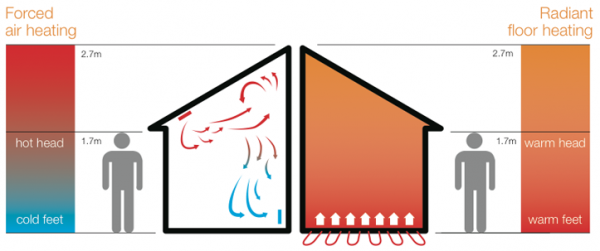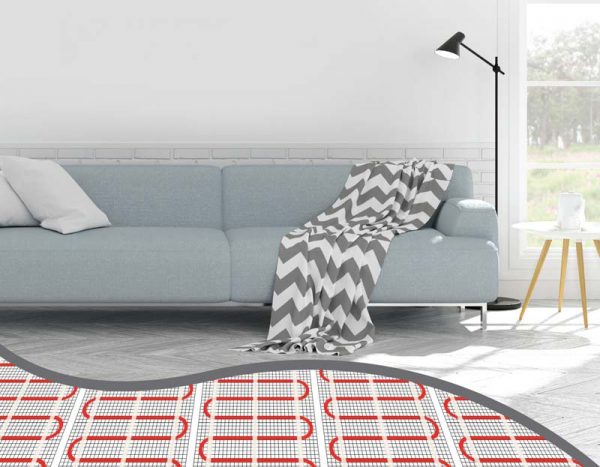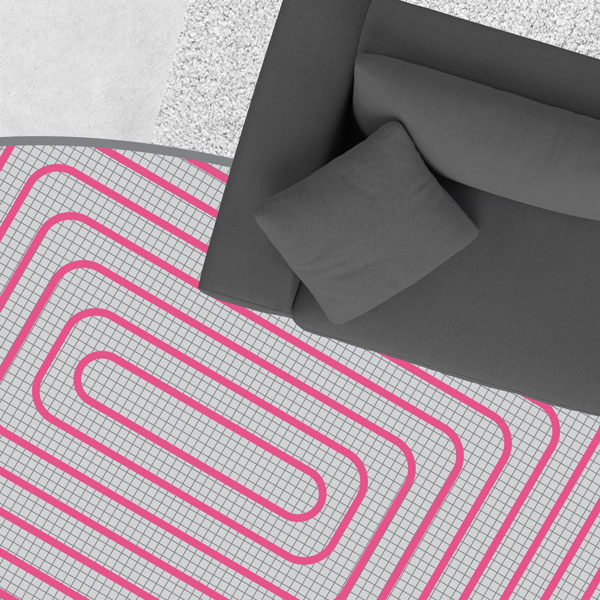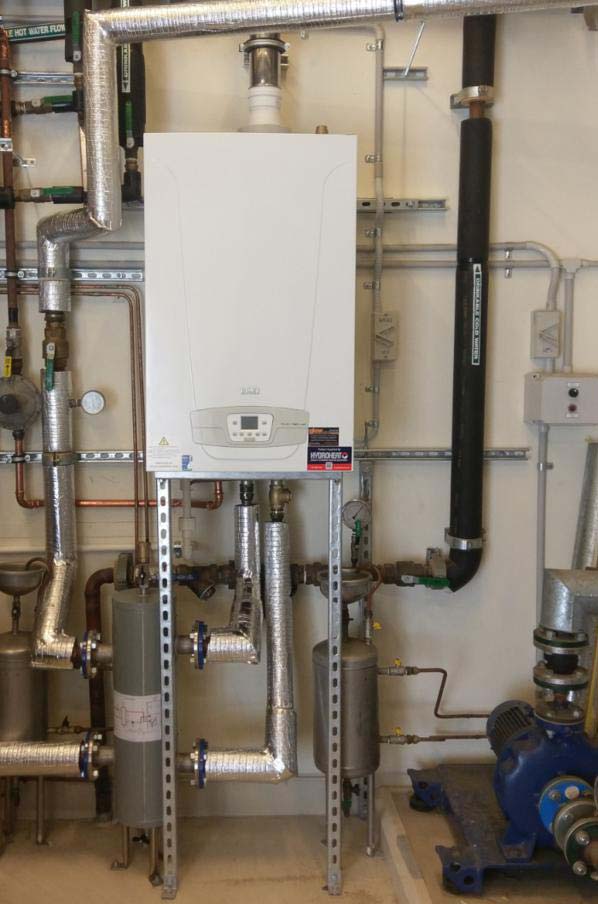Staying warm and comfortable all winter is a challenge with traditional forced-air heating and cooling. You balance energy costs against comfort, especially when you step onto cold tiles, or out of bed onto a chilly floor. This is because...
Staying warm and comfortable all winter is a challenge with traditional forced-air heating and cooling. You balance energy costs against comfort, especially when you step onto cold tiles, or out of bed onto a chilly floor. This is because there are serious limits on what forced-air systems can do.
Energy costs of forced-air systems can be too expensive for you to warm your entire home to a truly comfortable temperature in the winter. Costs are exacerbated by the very nature of these systems. For example, energy can be lost when heated air escapes through leaks in the ducts installed in your home. That heated air often escapes your home before it ever has a chance to warm up your favourite rooms. Depending on the age and condition of your forced-air heating system, these losses could represent as much as 50 percent of the energy your system consumes.
Fortunately, there’s another option. Radiant heating has become popular recently, and advances in system design and efficiency mean that it can easily surpass forced-air systems in both effectiveness and energy costs.
What is Radiant Heat?
There are two major kinds of radiant heat, electric and hydronic. Both can be installed beneath the floors of your rooms, also called sub-floor or underfloor heating. In electric radiant heat systems, cables are installed underneath the floor. These cables are heated by electricity, which warms the floor, and then the room. Electric systems are great for heating limited areas, such as a bathroom with a floor that never seems to be warm enough for you. However, due to the cost of electric heating, it’s not the best solution if you’re looking for an alternative to forced-air for your entire home.

That’s where hydronic underfloor heating shines. Instead of using cables that are warmed with electricity, hydronic floor heating systems use a series of tubes. Heated water flows through these tubes, which provide effective heating to the room above. In fact, hydronic radiant heat can create temperatures that are much more consistent throughout a home. No more getting a chill walking from your living room to your kitchen. If you want different temperatures in different rooms or at different times, such as cooling off your bedroom when it’s time for bed, many systems use thermostats that can be programmed to do so.
Everything You Need to Know About Electric Underfloor Heating
Choosing to switch all or part of your home to radiant heat can be liberating. It means that you’ll have more consistent and efficient heating. However, choosing which system to use can be challenging. These two different methods have different advantages and disadvantages, and the one that’s best for you depends entirely on what you’re looking to get out of your system. If you have any questions, a professional like Glow will be able to help you make a decision.

How Does Electric Underfloor Heating Work?
Heating coils are installed beneath the floor. These coils are different from the ones you’d find in a space heater or other electric heating device. Instead, they’re resistance wires. In many systems, these wires are embedded in a mat, which is then laid out in the area to be heated. Flooring material, like tile or carpet, is installed over top. Electricity is run through these coils, and they heat up. That heat is transferred to the flooring in the room above, and from there, it dissipates into the room, warming it. A temperature sensor on or near the floor will help the system maintain temperature by providing feedback about the amount of heat being generated.
There are different kinds of electric underfloor heating available based on the space that you want to heat, and you’ll also often have the option of installing a programmable thermostat to make sure that your rooms are always comfortable.
How Is an Electric Underfloor System Installed?
There are three components to a typical electrical underfloor heating installation:
Heating cables Temperature sensor ThermostatThe heating cables are frequently embedded in or woven into a plastic mat. This mat can be easily rolled over the subfloor, which means that this system is easy to install when you’re putting in a new floor. In that case, the new flooring will simply be installed on top, and the total cost of installation will only add a modest extra expense to your project cost.
Once the cables have been placed, they’ll have to be connected to a source of electricity. It’s safest if someone with training and experience, such as an electrician or heating specialist, handles this part of the installation. They’ll be able to test the cables and power source to make sure there aren’t any problems.
Since these systems are easy to install, they can be added to an existing room much more easily than a hydronic underfloor system.

How Efficient Is Electric Underfloor Heating?
Electric radiant heat can be an efficient way to heat a small part of your home. It’s a great choice for areas of your home where you tend to be barefoot, like your bathroom or bedroom, and where the floor just never seems to be warm enough.
Some electric underfloor heating systems operate on a timer, which means that they’re on for a set amount of time before turning off. This can be effective at maintaining a stable temperature. Other systems use a thermostat and floor sensor. Those systems are activated whenever the temperature drops below a specified point. Some of these thermostat-controlled systems are also programmable, giving you the control to set different temperatures for times when you’re not using the room, such as lowering the temperature in your kitchen or dining room at night.
Any of these systems can be an efficient way to warm cold flooring or limited areas of a home, and you’re not likely to see a huge increase in your electric bill when using them this way. However, trying to use electric underfloor heating as your primary heat source will be prohibitively expensive. If you’re interested in radiant heating for your entire home, consider a hydronic system as an option instead.
How Does Electric Underfloor Heating Perform?
Radiant heat, whether electric or hydronic, has some significant advantages over forced-air heating and cooling: It’s silent, invisible and doesn’t impact air quality.
There’s no sound when the system switches on or off. There aren’t any extra vents to impede your decorating scheme or collect dust or dirt. Electric underfloor heating can be a great supplement to your existing forced-air heating without having to rely on space heaters or other unsightly and inefficient methods of heating small areas.

Everything You Need to Know About Hydronic Underfloor Heating
Where electric floor heating uses cables, coils and electricity, hydronic underfloor heating uses tubes, water and whatever energy source you prefer. They’re efficient enough to use as a heating solution for your entire home, and they may reduce your energy costs by as much as 25 percent when compared to a forced-air system.
How Does Hydronic Floor Heating Work?
Tubes or small pipes beneath the floor are used to circulate heated water throughout the area. As the water flows through the system, the heat is released. Water can be heated in a number of different ways, which means that you’ll have many energy options when choosing hydronic heating:
Oil-fired boiler Gas-fired boiler Kerosene water heater Gas water heater Solar water heaterSome underfloor hydronic systems supplement these primary heat sources with solar energy. Choosing a solar-assisted system is environmentally friendly, and it can further reduce your heating costs. The best choice for heating your system depends on the size of your home and where it’s located. A professional can advise you on which method will be the most efficient. A system of pipes channels water from this heating source to the pipes under different rooms of your home, which means that you can set different temperatures for different rooms.
In installations in new homes, the pipes that run through individual rooms are put in place, and a concrete slab is poured over top. Heat from water moving through the pipes transfers into this concrete slab, which then warms the room.
Hydronic heating technology is constantly evolving. Recent advances have made these systems more efficient, especially in regards to the water temperature that’s required to reach desired heating levels. Advances in installation products and technology are also making hydronic heating more accessible. Because of these developments, now is the best time to consider installing a hydronic heating system for your home.
How Is Hydronic Underfloor Heating Installed?
The installation process for a hydronic heating system is much more involved than that for an electric system. In existing homes, the floor will have to be torn up and reinstalled in order to install effective hydronic heat, and that can be expensive. This makes hydronic heat a good choice for new construction, whether it’s an entirely new home or an extension of an existing home.
That’s not to say that it’s impossible to install hydronic heating in an existing home. In fact, doing so can be a valuable investment. It can reduce your energy costs, which means that it pays for itself over time, and it can also increase the value of your home. Manufacturers are also actively making advances that make it easier to install hydronic heating in existing structures in order to improve accessibility.
In addition to the extra steps required to install these systems in existing structures, the installation is complicated by the complexity of the systems themselves. A typical hydronic underfloor heating set up includes:
A boiler A pump Fuel lines Panels under the floorA professional technician should be engaged to install any of these systems.

How Efficient Is Hydronic Floor Heating?
Hydronic radiant heat can be one of the most efficient ways to heat your home. The nature of the system limits the amount of energy that can be wasted. By comparison, forced-air systems can lose so much heat through ducts that their efficiency is reduced by half. In a hydronic system, there’s significantly less heat loss.
Several other factors contribute to the efficiency of hydronic underfloor heating. Since the heat comes from the floor, it can keep you, your family and your friends comfortable at a lower set temperature than would be required for the same comfort from a traditional forced-air system. This method of heat distribution also means that the system doesn’t have to run for as long to heat up or to maintain the set temperature.
The efficiency of hydronic systems can also be improved by careful design and adequate insulation. A professional with training and experience, such as the radiant heat specialists at Glow, can help you create a system that maximises efficiency while helping you keep your home comfortable all year round.
How Does Hydronic Underfloor Heating Perform?
Hydronic radiant heating has many of the same advantages as its electric cousin. It’s silent and invisible, and it can help keep the air in your home clean and fresh by limiting the amount of dust and dirt that circulates. Unlike its electric cousin, it can be used to efficiently heat your entire home.
It’s especially effective in areas where forced-air heat can’t keep up with your heating needs. In addition to being installed beneath flooring, hydronic radiant heat systems can also be installed in walls and ceilings, which can help you heat trouble spots in your home.
Heating from these systems creates a uniform temperature in your home because it doesn’t rely on circulating air to provide warmth, which means that even the corners of your favourite rooms will be adequately heated. Additionally, you can use a programmable thermostat to set different temperatures in different rooms or at different times of the day. Programmable thermostats have been associated with both reduced heating costs and increased comfort.
Hydronic underfloor heating is a reliable replacement for forced-air heating and cooling systems, and it might even be cheaper in the long run.
Which Underfloor Heating Option Should I Choose?
The best heating option depends on what you want to accomplish. Underfloor heating, whether radiant electric or hydronic, is a good choice if:
You want a silent, invisible heating system. You want to improve the air quality in your home. You want consistent heat throughout your home, both within and between rooms. You hate cold floors. Someone in your home suffers from allergies or is sensitive to dustOnce you’ve decided that radiant underfloor heating is the best option for your heating needs, you’ll need to consider what kind of floor heating you want to install. Consider the following lists to help you make your choice.
Choose electric underfloor heating if:
You’re supplementing an existing heating system. You’re adding heating to a home or other building that already exists. The area you want to heat is relatively small, like a single master bathroom. Cold floors are a major source of your dissatisfaction with your current heating solution. You prefer a simple installation that can be performed alongside flooring renovations.Choose hydronic underfloor heating if:
You want to heat your entire home. You’re building a new home or other structure and want an efficient heating method, or you don’t mind significant renovations in order to benefit from the increased consistency and efficiency of radiant heat. You want some flexibility in the energy source for your home’s heat. You want to reduce your overall heating costs.If you’ve considered these factors and you’re still not sure whether installing electric floor heating in one part of your home or hydronic floor heating throughout your home is the best choice, consult with a specialist like Glow. They’ll be able to provide you with an estimate for each installation based on your home and your heating needs. With those estimates, you’ll be able to make an informed decision that takes into account the total cost of installation, the amount you can expect to save in energy costs and the increase in your personal comfort, especially through the cold winter months.
Glow can also give you extra information on the different kinds of systems they work with, options and the installation process. Additionally, they’ll be able to answer any other questions you might have about the benefits of radiant underfloor heating, both hydronic and electric. The experts at Glow are always happy to assist you with your queries.
The post What’s the Best Underfloor Heating Option – Hydronic or Electric? appeared first on Glow HCE.


